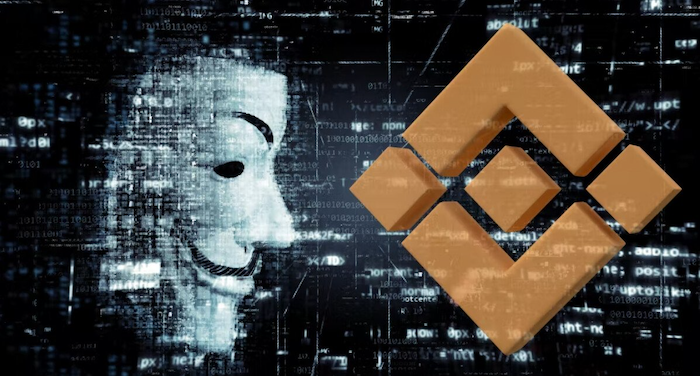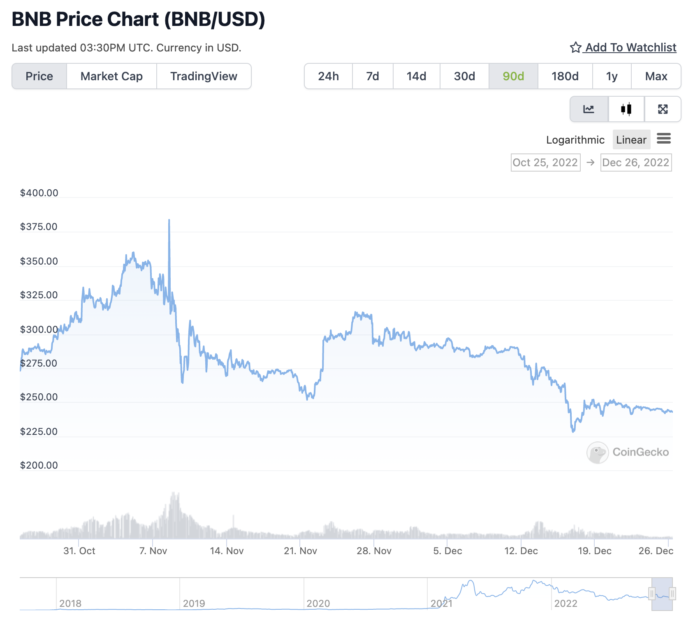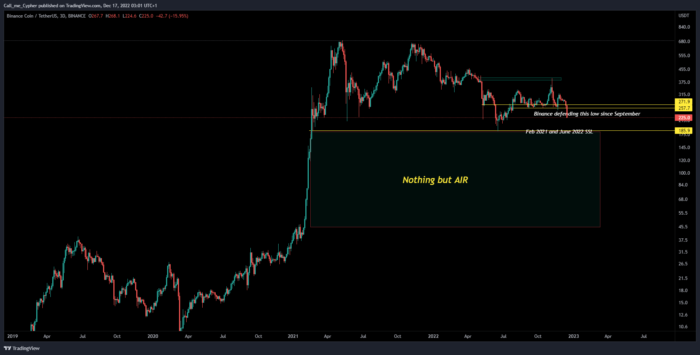There is no fire at Binance yet, but the smoke is filling the building.
Following the collapse of FTX all eyes have turned to the other opaque offshore exchanges, waiting and wondering which could be insolvent and about to detonate next. The similarities between FTX and Binance are numerous which is a major cause for concern. In the Crypto industry often where there’s smoke, there’s fire.
Binance’s Similarities with FTX
Both exchanges are located offshore, outside of the reach of major nation regulators. While FTX appears to have been cozy with the regulators in the Bahamas; Binance seems to have no fixed address, instead hopping between jurisdictions looking for friendly regulators along the way. This hasn’t been limited only to suspect jurisdictions like Dubai and Singapore, Binance most recently cozied up to regulators in France, gaining registration in the region as a home base for European operations.
We have very little information in the corporate structure of Binance. What little we do know is that there appears to be a complex web of ownership and subsidiaries scattered across various jurisdictions.
As Bloomberg put it in June: Binance “is based in who knows where and owned by god knows whom.”
The similarity in the exchange tokens offered by each company is obvious. FTX famously offered their FTT token to give discounts to users on the front end. Behind the scenes the token allowed FTX and their associated hedge fund, Alameda Research, to functionally print their own collateral to take loans against and use to fund buyouts throughout the industry.
Binance’s BNB token had similar origins, but has now moved on to become the ecosystem token for the fully fledged Ethereum competitor, Binance Smart Chain. There is no direct evidence that Binance has leveraged BNB in a similar way that FTX used FTT; but it’s not difficult to imagine some of the same balance sheet tricks have been used.
We do know that Binance operates a large ecosystem incubator called Binance Launchpad. This program allows startups to access funding in exchange for launching their projects on Binance Smart Chain. Recently details have emerged indicating that in order to list tokens on Binance, projects would be required to post a sizeable insurance deposit with the exchange. These deposits would be denominated in BNB, adding additional demand for the token.
Binance was the first money into FTX
Back in 2019, when FTX was getting off the ground they took on Binance as their first strategic investor. The size of the Binance investment remains undisclosed but we do know that alongside this investment, Binance received a sizable allocation of FTT tokens.
In July 2021, FTX suddenly bought out Binance’s stake, again for an undisclosed amount. What we didn’t know at the time was that despite raising $900M from fresh investors at the same time, FTX still funded a portion of the buyout using FTT tokens rather than fiat currency.

Binance was building up a gigantic bag of FTT tokens.
We all know what happened next, in November this year Binance CEO CZ announced that they would be divesting of their FTT tokens, crashing the market and shortly afterwards resulting in the bankruptcy of FTX.
While this background is important, it doesn’t necessarily follow that Binance is also insolvent. The links between FTX and Binance are simply too deep to ignore. The similarities in strategy are too many to dismiss as merely a coincidence.
It is entirely possible that Binance runs its business using exactly the same tricks as FTX but at a much larger scale.
Have you got my money?
Over the past several weeks, customers have decided to test the liquidity of Binance. After the collapse of FTX, Binance was one of the few exchanges that were seen as relatively trustworthy and saw inflows as users moved funds around. This all stopped recently when Binance published their “proof-of-reserves”.
Binance tried to promote their proof-of reserves report as an audit. It was nothing of the sort.
The report showed that Binance did indeed have some wallets with billions of dollars worth of Bitcoin in them. The report didn’t prove anything about non-Bitcoin assets and reserves. It didn’t prove how much the exchange owed to customers.
The report didn’t even prove that Binance had control of the wallets.
Industry figures immediately called Binance out. Kraken CEO Jesse Powell was particularly strong in his warning that the report proved basically nothing. The audit firm that conducted the report stopped working with Crypto firms shortly afterwards and deleted all of their publicly available Crypto reports, including the Binance reports.
Does Binance have enough reserves? Probably, but customers weren’t waiting around to find out.
In the week after the report was published, customers withdrew around $8B worth of assets. An additional $5B in assets flowed into the exchange, however some of these flows appeared to be emergency liquidity provided by other firms, used to service withdrawals. At one stage Binance halted withdrawals of USDC, claiming that they needed to wait for regular banking hours to top up their wallets.
Just like FTX, customers were draining the funds out of Binance.
Binance has largely serviced the withdrawals so far. That’s to be expected, it’s a gigantic entity and has a large amount of reserves. It might not have enough reserves to service withdrawals indefinitely, but for now the funds appear to be flowing.
What’s different this time?
Taking a closer look at the FTX run on deposits can give us some insight into how and why Binance might ultimately fail. The biggest difference between the two exchange runs is that the run on FTX began with a sell off in the exchange token, FTT. In contrast Binance’s BNB token has taken some punishment but the sell off has been nowhere near as extreme.
If Binance is running the same shell game as FTX, they will be solvent until BNB drops in value.

At FTX, the exchange token and various other Solana ecosystem tokens were the lifeblood of the exchange’s balance sheet. FTX and Alameda were holding FTT as a significant chunk of reserves, their internal financials were leveraged off FTT, and FTT was the major collateral held at external lenders.
FTX only hit problems when that collateral value fell and lenders pulled their credit lines.
According to Nansen, Binance holds around $54B in reserves. We don’t know what the liabilities attached to these assets are, but around $5.5B of these assets are BNB tokens. We know that Binance subsidizes margin loans for users using BNB as collateral. We know that 20% of BNB tokens are held off market and do not circulate (this is not uncommon for 2017-present era cryptos). We do not know how much of Binance’s business is based on leveraging BNB collateral. We have no idea whether Binance has an embedded market maker, like Alameda Research. We do know that Binance has cold wallets and reserves, while no one could ever find cold wallets for FTX.
There isn’t an obvious problem with Binance so far, but if something is going to break over at Binance it will likely start with a rapid devaluation of BNB tokens, rather than a bank run.
What happens next?
Binance has already weathered a major run. BNB has drawn down by almost 30% since problems showed up at FTX in early November. The stress is palpable, but at the end of the day Binance is a juggernaut. It is the largest exchange by a long way. It has daily volumes an order of magnitude larger than all of its competitors bar Coinbase. We know there are reserves and the exchange has been servicing a huge amount of withdrawals with relatively small hiccups.
I still don’t trust Binance. There is no reason to store your coins on Binance unless you are trading them.
I fully expect that a gigantic amount of Binance’s business is leveraged off BNB being used as collateral, and that if the value of BNB drops too much it causes some major problems. But I don’t know for sure. In June, while the rest of the Crypto markets were blowing up BNB was defended strongly at $200. Make of that what you will.

Overall these problems at Binance feel a lot like previous waves of FUD surrounding Tether. The entire thing looks and seems dodgy, but over the last 5 years basically everyone who has been too enthusiastic and piled into shorts has been chewed up and spat out.
The casino isn’t fair, but betting that the house will break is usually a losing bet.
Stepping back, I don’t think that Binance will end up blowing up like FTX did. They don’t seem to be taking the same sorts of risk with their business operations. If there is an issue that ends up bringing down Binance it seems much more likely that a major regulatory crackdown does the just than just a run on deposits.
There are plenty of angles that could get attacked by regulators. Binance operates a regulated Crypto on-ramp in a multitude of jurisdictions. They are allowed to accept bank deposits through these entities. Any major attempt to shut down Binance via these local on-ramps could have significant ripple effects throughout the rest of the Binance empire by constricting fresh deposits.
For now, Binance looks the shakiest it has since 2018. They have giant reserves and regulatory obfuscation. They’ve also been playing this game for a long time and have grown the largest among competitors.
That’s not a good excuse to leave your funds there. This is one you want to watch from the outside (Editor’s note: We’re so adamant you should be self-custodying your Bitcoin that we’ll even pay you to do it. )
Eventually Binance could break, and I don’t want to wait to find out. For now, there is no fire. Only lots and lots of smoke.
Today’s post is from contributing analyst Scott Hill. To receive further updates of this series and our overall investment thesis for digital assets (even in this climate), subscribe to the Bombthrower mailing list.



Binance regularly (for years) halts Monero (XMR) withdrawals .. usually citing bogus 'network issues' – when no one else on the XMR network is having issues.
It is pretty clear that they are doing fractional reserve tricks with XMR …. and any XMR balance you have with them is probably 'paper XMR' like GLD is 'paper Gold' …. this fractional reserve problem is one of the things suppressing the exchange rates of XMR/fiat … just like GLD is used to suppress the exchange rate of Gold/fiat
Same rule for people – take your crypto off the exchanges. I avoided the MtGox debacle by simply following that rule.
Is 'crypto' and 'bitcoin' simply an arrangement of transistors? If anyone can contradict this please let me know.